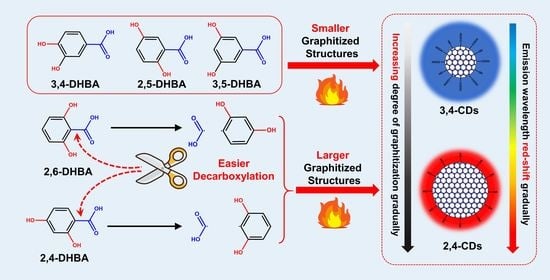Synthesis of Multiple Emission Carbon Dots from Dihydroxybenzoic Acid via Decarboxylation Process
Abstract
1. Introduction
2. Materials and Methods
2.1. Reagents and Materials
2.2. Preparation of the Five CDs and CDs@C3N4 Composite Photocatalyst
2.3. Photocatalytic Hydrogen Evolution
3. Results and Discussion
3.1. The Optical Properties of CDs
3.2. The Structure Properties of CDs
3.3. The Fluorescence Mechanism and Forming Process of CDs
3.4. The Facilitated Photocatalysis of g-C3N4 by CDs
4. Conclusions
Supplementary Materials
Author Contributions
Funding
Data Availability Statement
Conflicts of Interest
References
- Zheng, M.; Ruan, S.; Liu, S.; Sun, T.; Qu, D.; Zhao, H.; Xie, Z.; Gao, H.; Jing, X.; Sun, Z. Self-Targeting Fluorescent Carbon Dots for Diagnosis of Brain Cancer Cells. ACS Nano 2015, 9, 11455–11461. [Google Scholar] [CrossRef]
- Qu, D.; Zheng, M.; Du, P.; Zhou, Y.; Zhang, L.; Li, D.; Tan, H.; Zhao, Z.; Xie, Z.; Sun, Z. Highly Luminescent S, N Co-doped Graphene Quantum Dots with Broad Visible Absorption Bands for Visible Light Photocatalysts. Nanoscale 2013, 5, 12272–12277. [Google Scholar] [CrossRef]
- Qu, D.; Liu, J.; Miao, X.; Han, M.; Zhang, H.; Cui, Z.; Sun, S.; Kang, Z.; Fan, H.; Sun, Z. Peering into Water Splitting Mechanism of g-C3N4-carbon Dots Metal-free Photocatalyst. Appl. Catal. B 2018, 227, 418–424. [Google Scholar] [CrossRef]
- Li, D.; Jing, P.; Sun, L.; An, Y.; Shan, X.; Lu, X.; Zhou, D.; Han, D.; Shen, D.; Zhai, Y.; et al. Near-Infrared Excitation/Emission and Multiphoton-Induced Fluorescence of Carbon Dots. Adv. Mater. 2018, 30, 1705913–1705920. [Google Scholar] [CrossRef]
- Bao, X.; Yuan, Y.; Chen, J.; Zhang, B.; Li, D.; Zhou, D.; Jing, P.; Xu, G.; Wang, Y.; Hola, K.; et al. In Vivo Theranostics with Near-infrared-emitting Carbon Dots-highly Efficient Photothermal Therapy Based on Passive Targeting after Intravenous Administration. Light Sci. Appl. 2018, 7, 91–101. [Google Scholar] [CrossRef]
- Qu, D.; Yang, D.; Sun, Y.; Wang, X.; Sun, Z. White Emissive Carbon Dots Actuated by the H-/J-Aggregates and Forster Resonance Energy Transfer. J. Phys. Chem. Lett. 2019, 10, 3849–3857. [Google Scholar] [CrossRef] [PubMed]
- Ding, H.; Zhou, X.-X.; Zhang, Z.-H.; Zhao, Y.-P.; Wei, J.-S.; Xiong, H.-M. Large Scale Synthesis of Full-color Emissive Carbon Dots from a Aingle Carbon Source by a Solvent-free Method. Nano Res. 2021, 15, 3548–3555. [Google Scholar] [CrossRef]
- Qu, S.; Wang, X.; Lu, Q.; Liu, X.; Wang, L. A Biocompatible Fluorescent Ink Based on Water-soluble Luminescent Carbon Nanodots. Angew. Chem. Int. Ed. Engl. 2012, 51, 12215–12218. [Google Scholar] [CrossRef] [PubMed]
- Zheng, M.; Xie, Z.; Qu, D.; Li, D.; Du, P.; Jing, X.; Sun, Z. On-off-on Fluorescent Carbon Dot Nanosensor for Recognition of Chromium(VI) and Ascorbic Acid Based on the Inner Filter Effect. ACS Appl. Mater. Interfaces 2013, 5, 13242–13247. [Google Scholar] [CrossRef]
- Miao, X.; Qu, D.; Yang, D.; Nie, B.; Zhao, Y.; Fan, H.; Sun, Z. Synthesis of Carbon Dots with Multiple Color Emission by Controlled Graphitization and Surface Functionalization. Adv. Mater. 2018, 30, 1704740. [Google Scholar] [CrossRef]
- Liu, Y.; Lei, J.H.; Wang, G.; Zhang, Z.; Wu, J.; Zhang, B.; Zhang, H.; Liu, E.; Wang, L.; Liu, T.M.; et al. Toward Strong Near-Infrared Absorption/Emission from Carbon Dots in Aqueous Media through Solvothermal Fusion of Large Conjugated Perylene Derivatives with Post-Surface Engineering. Adv. Sci. 2022, 9, e2202283–e2202293. [Google Scholar] [CrossRef]
- Jiang, K.; Hu, S.; Wang, Y.; Li, Z.; Lin, H. Photo-Stimulated Polychromatic Room Temperature Phosphorescence of Carbon Dots. Small 2020, 16, e2001909. [Google Scholar] [CrossRef]
- Niu, X.; Song, T.; Xiong, H. Large Scale Synthesis of Red Emissive Carbon Dots Powder by Solid State Reaction for Fingerprint Identification. Chin. Chem. Lett. 2021, 32, 1953–1956. [Google Scholar] [CrossRef]
- Jiang, K.; Wang, Y.; Gao, X.; Cai, C.; Lin, H. Facile, Quick, and Gram-Scale Synthesis of Ultralong-Lifetime Room-Temperature-Phosphorescent Carbon Dots by Microwave Irradiation. Angew. Chem. Int. Ed. Engl. 2018, 57, 6216–6220. [Google Scholar] [CrossRef] [PubMed]
- Zhu, Z.; Cheng, R.; Ling, L.; Li, Q.; Chen, S. Rapid and Large-Scale Production of Multi-Fluorescence Carbon Dots by a Magnetic Hyperthermia Method. Angew. Chem. Int. Ed. Engl. 2020, 59, 3099–3105. [Google Scholar] [CrossRef]
- Jiang, K.; Sun, S.; Zhang, L.; Lu, Y.; Wu, A.; Cai, C.; Lin, H. Red, Green, and Blue Luminescence by Carbon Dots: Full-Color Emission Tuning and Multicolor Cellular Imaging. Angew. Chem. Int. Ed. Engl. 2015, 54, 5360–5363. [Google Scholar] [CrossRef]
- Li, P.; Xue, S.; Sun, L.; Zong, X.; An, L.; Qu, D.; Wang, X.; Sun, Z. Formation and Fluorescent Mechanism of Red Emissive Carbon Dots from o-phenylenediamine and Catechol System. Light Sci. Appl. 2022, 11, 298–310. [Google Scholar] [CrossRef]
- Xia, X.; Deng, N.; Cui, G.; Xie, J.; Shi, X.; Zhao, Y.; Wang, Q.; Wang, W.; Tang, B. NIR Light Induced H2 Evolution by a Metal-Free Photocatalyst. Chem. Commun. 2015, 51, 10899–10902. [Google Scholar] [CrossRef]
- Zhang, S.; Gao, M.; Zhai, Y.; Wen, J.; Yu, J.; He, T.; Kang, Z.; Lu, S. Which Kind of Nitrogen Chemical States Doped Carbon Dots Loaded by g-C3N4 is the Best for Photocatalytic Hydrogen Production. J. Colloid. Interface. Sci. 2022, 622, 662–674. [Google Scholar] [CrossRef] [PubMed]
- Ding, H.; Yu, S.B.; Wei, J.S.; Xiong, H.M. Full-Color Light-Emitting Carbon Dots with a Surface-State-Controlled Luminescence Mechanism. ACS Nano 2016, 10, 484–491. [Google Scholar] [CrossRef] [PubMed]
- Lyu, B.; Li, H.-J.; Xue, F.; Sai, L.; Gui, B.; Qian, D.; Wang, X.; Yang, J. Facile, Gram-scale and Eco-friendly Synthesis of Multicolor Graphene Quantum Dots by Thermal-driven Advanced Oxidation Process. Chem. Eng. J. 2020, 388, 124285. [Google Scholar] [CrossRef]
- Sun, M.; Liang, C.; Tian, Z.; Ushakova, E.V.; Li, D.; Xing, G.; Qu, S.; Rogach, A.L. Realization of the Photostable Intrinsic Core Emission from Carbon Dots through Surface Deoxidation by Ultraviolet Irradiation. J. Phys. Chem. Lett. 2019, 10, 3094–3100. [Google Scholar] [CrossRef] [PubMed]
- Verma, N.C.; Yadav, A.; Nandi, C.K. Paving the Path to the Future of Carbogenic Nanodots. Nat. Commun. 2019, 10, 2391. [Google Scholar] [CrossRef]
- Yan, F.; Jiang, Y.; Sun, X.; Wei, J.; Chen, L.; Zhang, Y. Multicolor Carbon Dots with Concentration-tunable Fluorescence and Solvent-affected Aggregation States for White Light-emitting Diodes. Nano Res. 2020, 13, 52–60. [Google Scholar] [CrossRef]
- Li, D.; Liang, C.; Ushakova, E.V.; Sun, M.; Huang, X.; Zhang, X.; Jing, P.; Yoo, S.J.; Kim, J.G.; Liu, E.; et al. Thermally Activated Upconversion Near-Infrared Photoluminescence from Carbon Dots Synthesized via Microwave Assisted Exfoliation. Small 2019, 15, e1905050. [Google Scholar] [CrossRef]
- Zhang, Q.; Wang, R.; Feng, B.; Zhong, X.; Ostrikov, K.K. Photoluminescence Mechanism of Carbon Dots: Triggering High-color-purity Red Fluorescence Emission Through Edge Amino Protonation. Nat. Commun. 2021, 12, 6856–6868. [Google Scholar] [CrossRef]
- Xue, S.; Li, P.; Sun, L.; An, L.; Qu, D.; Wang, X.; Sun, Z. The Formation Process and Mechanism of Carbon Dots Prepared from Aromatic Compounds as Precursors: A Review. Small 2023, e2206180. [Google Scholar] [CrossRef]
- Shangxian, Y.; Jiangnan, G.; Xiaoyuan, F.; Juhao, X. Synthesis and photosensitivity of tung oil-resorcin resin. J. Photopolym. Sci. Technol. 1998, 1, 71–182. [Google Scholar]
- Jiangnan, G.; Xiao, T.; Yingquan, Z.; Shaoren, H.; Shangxian, Y. Reactivity Determination of Carbon Atoms on Benzene Rings of Phenols. Proc. SPIE 1999, 3678, 440–447. [Google Scholar]
- Jia, H.; Wang, Z.; Yuan, T.; Yuan, F.; Li, X.; Li, Y.; Tan, Z.; Fan, L.; Yang, S. Electroluminescent Warm White Light-Emitting Diodes Based on Passivation Enabled Bright Red Bandgap Emission Carbon Quantum Dots. Adv. Sci. 2019, 6, e1900397–e1900406. [Google Scholar] [CrossRef] [PubMed]
- Ma, Z.; Zong, X.; Hong, Q.; Niu, L.; Yang, T.; Jiang, W.; Qu, D.; An, L.; Wang, X.; Kang, Z.; et al. Electrostatic potential of the incorporated asymmetry molecules induced high charge separation efficiency of the modified carbon nitride copolymers. Appl. Catal. B 2022, 319, 121922. [Google Scholar] [CrossRef]
- Sun, C.; Xu, Q.; Xie, Y.; Ling, Y.; Jiao, J.; Zhu, H.; Zhao, J.; Liu, X.; Hu, B.; Zhou, D. High-efficient One-pot Synthesis of Carbon Quantum Dots Decorating Bi2MoO6 Nanosheets Heterostructure with Enhanced Visible-light Photocatalytic Properties. J. Alloys Compd. 2017, 723, 333–344. [Google Scholar] [CrossRef]
- Tian, J.; Leng, Y.; Zhao, Z.; Xia, Y.; Sang, Y.; Hao, P.; Zhan, J.; Li, M.; Liu, H. Carbon Quantum dots/hydrogenated TiO2 Nanobelt Heterostructures and Their Broad Spectrum Photocatalytic Properties under UV, Visible, and Near-infrared Irradiation. Nano Energy 2015, 11, 419–427. [Google Scholar] [CrossRef]
- Zhang, Z.; Zheng, T.; Xu, J.; Zeng, H.; Zhang, N. Carbon Quantum Dots/Bi2WO6 Composites for Efficient Photocatalytic Pollutant Degradation and Hydrogen Evolution. Nano 2017, 12, 1750082. [Google Scholar] [CrossRef]
- Li, S.; Hu, S.; Jiang, W.; Liu, Y.; Zhou, Y.; Liu, J.; Wang, Z. Facile Synthesis of Cerium Oxide Nanoparticles Decorated Flower-like Bismuth Molybdate for Enhanced Photocatalytic Activity toward Organic Pollutant Degradation. J. Colloid. Interf. Sci. 2018, 530, 171–178. [Google Scholar] [CrossRef]
- Gogoi, D.; Koyani, R.; Golder, A.K.; Peela, N.R. Enhanced Photocatalytic Hydrogen Evolution using Green Carbon Quantum Dots Modified 1-D CdS Nanowires under Visible Light Irradiation. Sol. Energy 2020, 208, 966–977. [Google Scholar] [CrossRef]
- Liu, J.; Liu, Y.; Liu, N.; Han, Y.; Zhang, X.; Huang, H.; Lifshitz, Y.; Lee, S.-T.; Zhong, J.; Kang, Z. Metal-free Efficient Photocatalyst for Stable Visible Water Splitting via a Two-electron Pathway. Science 2015, 347, 970–974. [Google Scholar] [CrossRef]
- Li, L.; Zhu, X. Enhanced Photocatalytic Hydrogen Evolution of Carbon Quantum Dot Modified 1D Protonated Nanorods of Graphitic Carbon Nitride. ACS Appl. Nano Mater. 2018, 1, 5337–5344. [Google Scholar] [CrossRef]
- Xie, Z.; Yu, S.; Fan, X.-B.; Wei, S.; Yu, L.; Zhong, Y.; Gao, X.-W.; Wu, F.; Zhou, Y. Wavelength-sensitive Photocatalytic H2 Evolution from H2S Splitting over g-C3N4 with S,N-codoped Carbon Dots as The Photosensitizer. J. Energy Chem. 2021, 52, 234–242. [Google Scholar] [CrossRef]
- Naseri, A.; Samadi, M.; Pourjavadi, A.; Moshfegh, A.Z.; Ramakrishna, S. Graphitic Carbon Nitride (g-C3N4)-based Photocatalysts for Solar Hydrogen Generation: Recent Advances and Future Development Directions. J. Mater. Chem. A 2017, 5, 23406–23433. [Google Scholar] [CrossRef]
- Wang, Q.; Yang, Z. Industrial Water Pollution, Water Environment Treatment, and Health Risks in China. Environ. Pollut. 2016, 218, 358–365. [Google Scholar] [CrossRef] [PubMed]
- Ajmal, A.; Majeed, I.; Malik, R.N.; Idriss, H.; Nadeem, M.A. Principles and, Mechanisms of Photocatalytic Dye Degradation on TiO2 Based Photocatalysts: A Comparative Overview. RSC Adv. 2014, 4, 37003–37026. [Google Scholar] [CrossRef]
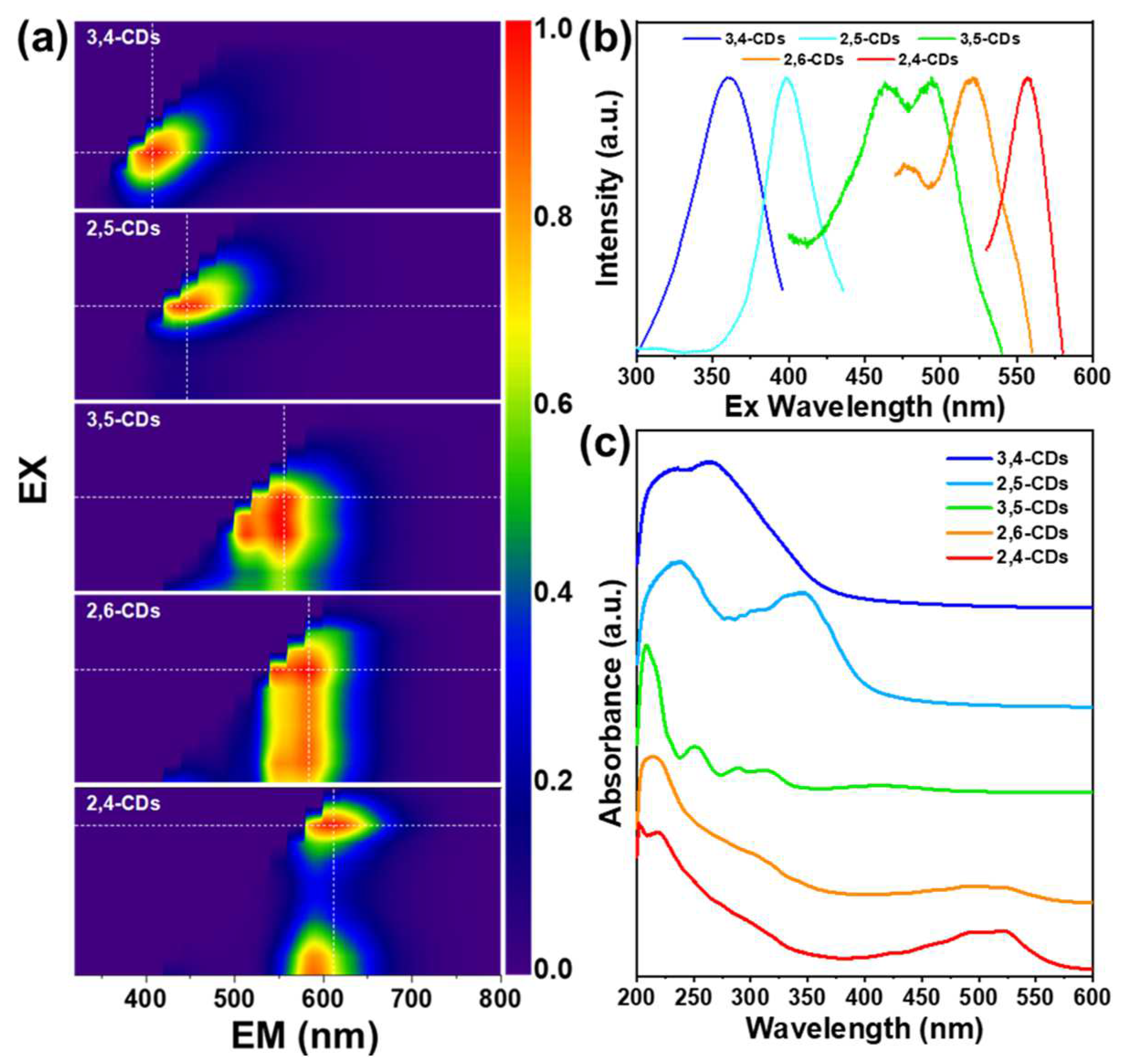


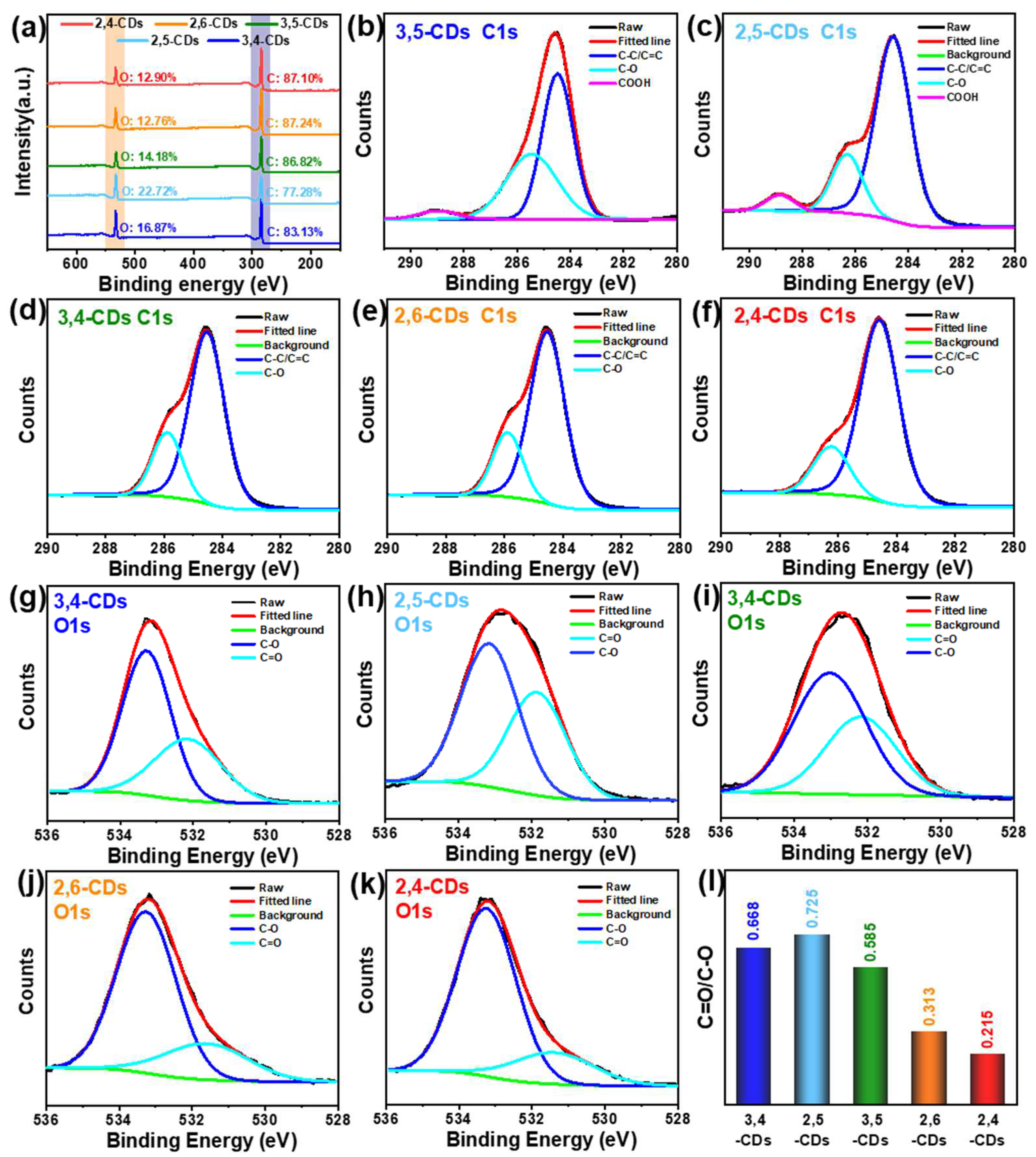
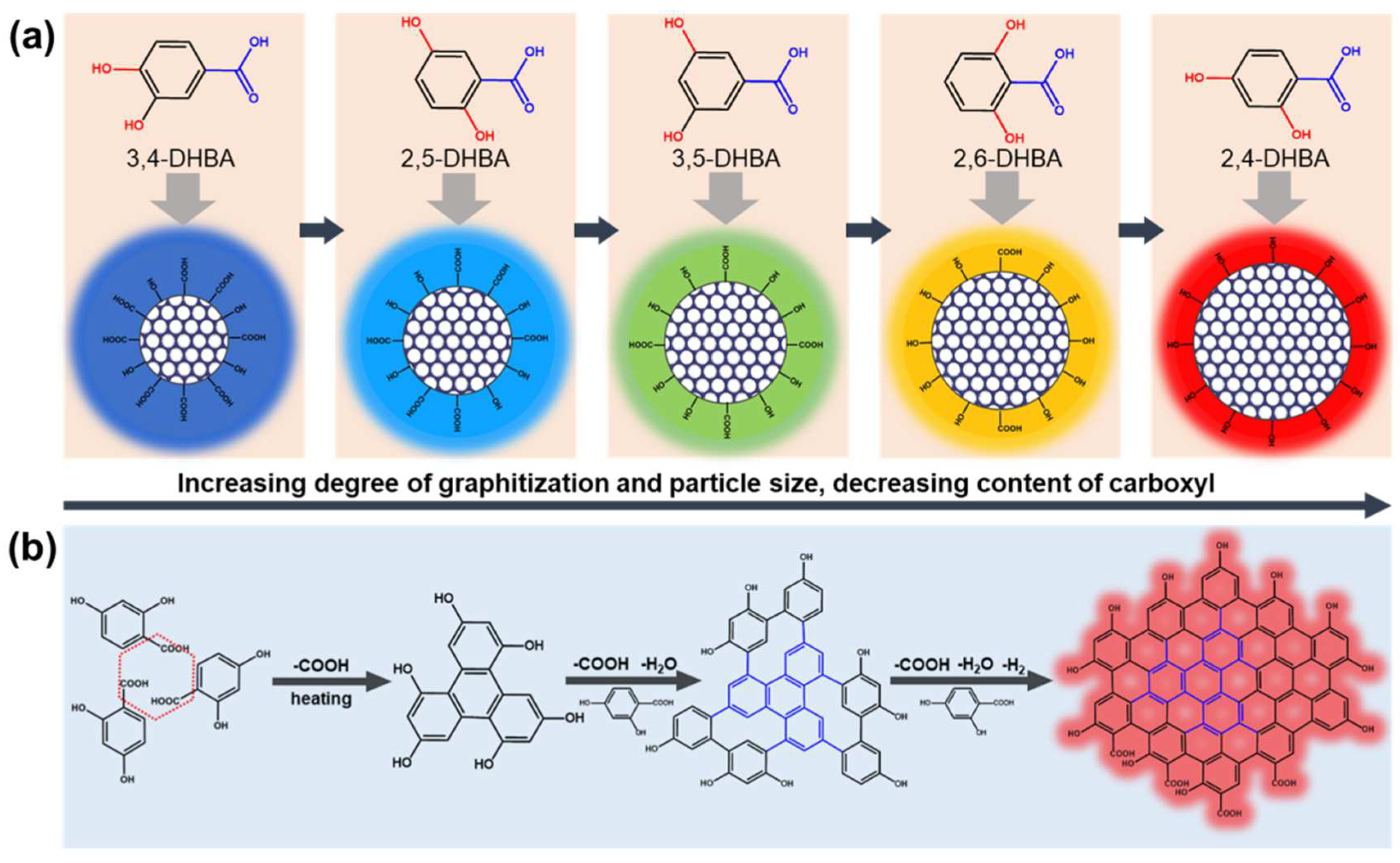

Disclaimer/Publisher’s Note: The statements, opinions and data contained in all publications are solely those of the individual author(s) and contributor(s) and not of MDPI and/or the editor(s). MDPI and/or the editor(s) disclaim responsibility for any injury to people or property resulting from any ideas, methods, instructions or products referred to in the content. |
© 2023 by the authors. Licensee MDPI, Basel, Switzerland. This article is an open access article distributed under the terms and conditions of the Creative Commons Attribution (CC BY) license (https://creativecommons.org/licenses/by/4.0/).
Share and Cite
Li, P.; Xu, J.; Shen, Z.; Liu, W.; An, L.; Qu, D.; Wang, X.; Sun, Z. Synthesis of Multiple Emission Carbon Dots from Dihydroxybenzoic Acid via Decarboxylation Process. Nanomaterials 2023, 13, 2062. https://doi.org/10.3390/nano13142062
Li P, Xu J, Shen Z, Liu W, An L, Qu D, Wang X, Sun Z. Synthesis of Multiple Emission Carbon Dots from Dihydroxybenzoic Acid via Decarboxylation Process. Nanomaterials. 2023; 13(14):2062. https://doi.org/10.3390/nano13142062
Chicago/Turabian StyleLi, Pengfei, Jijian Xu, Ziye Shen, Wenning Liu, Li An, Dan Qu, Xiayan Wang, and Zaicheng Sun. 2023. "Synthesis of Multiple Emission Carbon Dots from Dihydroxybenzoic Acid via Decarboxylation Process" Nanomaterials 13, no. 14: 2062. https://doi.org/10.3390/nano13142062
APA StyleLi, P., Xu, J., Shen, Z., Liu, W., An, L., Qu, D., Wang, X., & Sun, Z. (2023). Synthesis of Multiple Emission Carbon Dots from Dihydroxybenzoic Acid via Decarboxylation Process. Nanomaterials, 13(14), 2062. https://doi.org/10.3390/nano13142062






